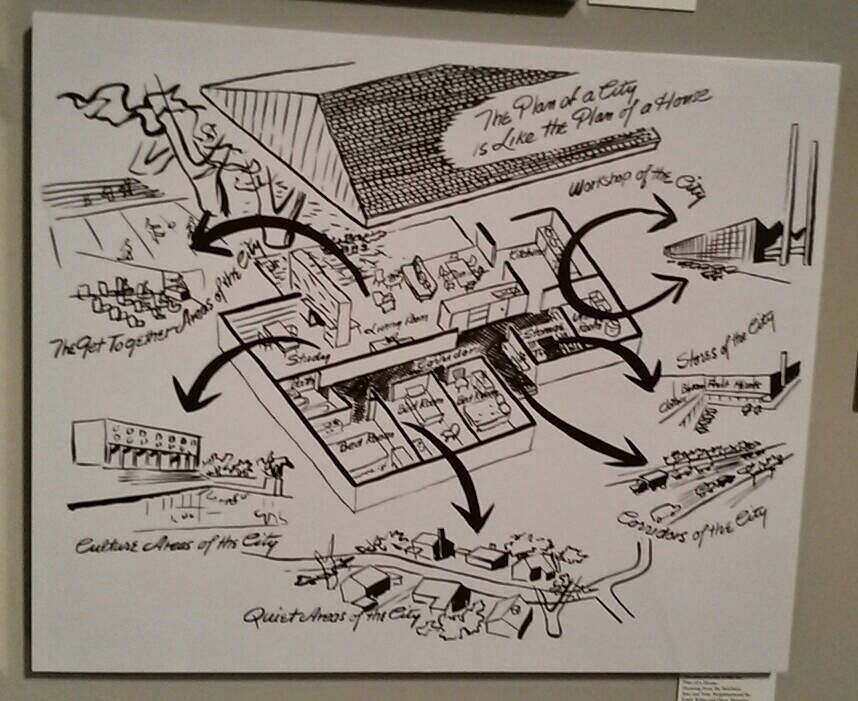The Design Museum in London hosts the awesome Design of the Year exhibition which I encourage anyone to visit. From July to October 2014 they also showed a collection of architect Louis Kahn's work. One idea from Kahn really stuck in my mind - The Plan of a City is Like the Plan of a Home. It got me thinking about Fractal Systems Architectures.
Louis Kahn's works are considered as monumental beyond modernism. Famous for his meticulously built works, his provocative unbuilt proposals, and his teaching, Kahn was one of the most influential architects of the 20th century.
The print above refers areas of the typical home to areas of the typical city for example the Study relates to the cultural areas of the city and the corridors relate to pavements and roads. As intended it raises some interesting question about town and city planning and it may not be a complete model for the urban environment e.g. where is law and order?
Mandelbrot described fractals as "a rough or fragmented geometric shape that can be split into parts, each of which is (at least approximately) a reduced-size copy of the whole". Following Khan's work, the city could be split into buildings that are approximately a reduce-size copy of the city. A police station would have toilets, canteen, quiet areas. A library would have similar.
It got me wondering if there were similar heuristics around system architectures in other fields. Here are some examples that may fit that description:
Then if systems could be thought of as fractal - so what? What are the benefits of being fractal. How fractal is enough? How can you measure the 'fractalness' of a system anyway?
A paper by Nary Subramanian (Ref. 1) uses this idea to measure complexity of an information system by modelling it as a fractal and calculating its fractal dimensions. They describe fractals as 'recurring patterns at multiple scales... [that] can be evaluated by means of their dimensions."
In another paper Ferrari and Sangiovanni-Vincentelli mention the "fractal nature of design i.e. the design problem repeats itself at every level of the hierarchy". Therefore perhaps design solutions repeat themselves at every level of the hierarchy? Something akin to the notion of Design Patterns that can be applied at any level of a fractal system?
Louis Kahn's works are considered as monumental beyond modernism. Famous for his meticulously built works, his provocative unbuilt proposals, and his teaching, Kahn was one of the most influential architects of the 20th century.
The print above refers areas of the typical home to areas of the typical city for example the Study relates to the cultural areas of the city and the corridors relate to pavements and roads. As intended it raises some interesting question about town and city planning and it may not be a complete model for the urban environment e.g. where is law and order?
Mandelbrot described fractals as "a rough or fragmented geometric shape that can be split into parts, each of which is (at least approximately) a reduced-size copy of the whole". Following Khan's work, the city could be split into buildings that are approximately a reduce-size copy of the city. A police station would have toilets, canteen, quiet areas. A library would have similar.
It got me wondering if there were similar heuristics around system architectures in other fields. Here are some examples that may fit that description:
- A web application running on a cluster of servers that scales up and down with demand
- A military force operating as battalions, companies and platoons.
- A political system governing internationally, nationally, locally.
Then if systems could be thought of as fractal - so what? What are the benefits of being fractal. How fractal is enough? How can you measure the 'fractalness' of a system anyway?
A paper by Nary Subramanian (Ref. 1) uses this idea to measure complexity of an information system by modelling it as a fractal and calculating its fractal dimensions. They describe fractals as 'recurring patterns at multiple scales... [that] can be evaluated by means of their dimensions."
In another paper Ferrari and Sangiovanni-Vincentelli mention the "fractal nature of design i.e. the design problem repeats itself at every level of the hierarchy". Therefore perhaps design solutions repeat themselves at every level of the hierarchy? Something akin to the notion of Design Patterns that can be applied at any level of a fractal system?
References
1 Subramanian, Nary. Advanced Information Systems Engineering Workshops. pp308-317 Vol. 83. Lecture Notes in Business Information Processing. Berlin, Heidelberg: Springer Berlin Heidelberg, 2011. http://link.springer.com/10.1007/978-3-642-22056-2.
2 Ferrari, A., and A. Sangiovanni-Vincentelli. “System Design: Traditional Concepts and New Paradigms,” 2–12. IEEE Comput. Soc, 1999. doi:10.1109/ICCD.1999.808256.

No comments:
Post a Comment